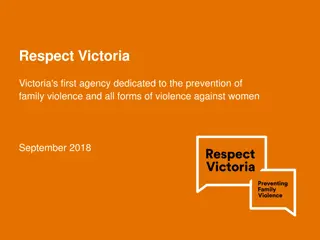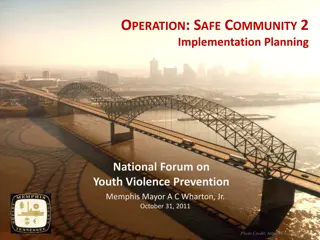Addressing Firearm Violence in Houston: A Data-Driven Approach
Despite efforts to reduce firearm-related deaths and injuries, the issue has worsened in Houston, with firearm deaths now surpassing those from motor vehicle crashes or illness, especially among children. The Houston Health Department is utilizing a detailed injury prevention framework to analyze data and target interventions to combat the rising trend of firearm violence. Data-driven approaches, similar to successful COVID-19 response strategies, are being implemented to identify hotspots and high-risk demographics for tailored intervention planning.
Download Presentation

Please find below an Image/Link to download the presentation.
The content on the website is provided AS IS for your information and personal use only. It may not be sold, licensed, or shared on other websites without obtaining consent from the author.If you encounter any issues during the download, it is possible that the publisher has removed the file from their server.
You are allowed to download the files provided on this website for personal or commercial use, subject to the condition that they are used lawfully. All files are the property of their respective owners.
The content on the website is provided AS IS for your information and personal use only. It may not be sold, licensed, or shared on other websites without obtaining consent from the author.
E N D
Presentation Transcript
Dr. Loren Hopkins, PhD, Chief Environmental Science Officer, Houston Health Dept. Dr. Bindi Naik, MD, MPH, Chief of Pediatric Surgery and Trauma, UTMB and Rice University Baker Institute for Public Policy Presentation Date: July 20, 2023
Despite including Reduce firearm-related deaths and Reduce non-fatal firearm-related injuries as Healthy People 2030 goals, the issue has not improved. Since 2020, death by firearm is now the LEADING cause of death in children, more than from motor vehicle crashes or illness. Firearm suicide and homicide has increased for both adults and children. All trauma centers in Houston have seen a huge increase in firearm injury victims since the pandemic, and this has been steadily rising since 2018.
ASSAULT / HOMICIDE INTERPERSONAL VIOLENCE MASS SHOOTINGS UNINTENTIONAL ACCIDENTAL NON-FATAL FATAL SUICIDE BYSTANDER STRAY BULLET INTENTIONAL SELF-HARM
INJURY PREVENTION FRAMEWORK (CDC) Detailed understanding of who, what, when, where, and why firearm-related injuries and deaths occur is needed to target interventions and break the trend of increasing firearm violence. The Houston Health Department (HHD) collects, analyzes, and presents data across disparate databases and surveillance systems to define: Who is most vulnerable for a firearm event? What types of firearm events are occurring? (intent) When and Where are the firearm events most often occurring? Why are the firearm events occurring? (risk factors, vulnerable populations)
Data-driven approaches have been key to implementing successful prevention/intervention efforts, not just for violence: City of Houston COVID-19 Response Integrated positivity, vaccination, and wastewater data to identify and address geographical hotspots and populations to target efforts. City of Houston, Out-of-Hospital Cardiac Arrest (OHCA)/Bystander CPR Identified hotspots of high OHCA, low bystander CPR rates, and high-risk demographics to effectively target culturally appropriate community-based intervention planning This approach provides timely integrated data that can be brought together quickly that can be actionable.
LEVEL I TRAUMA CENTERS MEDICAL EXAMINER RECORDS POLICE RECORDS Non-fatal injuries Fatal injuries Residence and shooting locations Shooting intent Social correlates All crimes involving guns Shooting locations Fatal injuries Residence and shooting locations Shooting intent Social correlates GEOSPATIAL ANALYSIS USING CENSUS BUREAU AND PLANNING AGENCY (H-GAC) Neighborhood-level risk factors, hot spots
ADULT FIREARM INJURIES AND DEATHS IN HARRIS COUNTY N=4,737 PEDIATRIC FIREARM INJURIES AND DEATHS DATA HARRIS COUNTY (0-17Y) N=485 * 2500 67% increase 2000 200 76% increase 1500 150 1000 100 500 0 2018 2019 2020 2018 2019 2020 DATA FROM ALL LEVEL 1 TRAUMA CENTERS AND ME OFFICE
HOTSPOTS FIREARM CRIME DATA FROM HPD, HCSO, Baytown PD and Pasadena PD 1,800 firearm deaths 8,600 firearm injuries
SUICIDE BYSTANDER ACCIDENTAL ASSAULT
Vulnerable populations *Except for suicide: 59% White, non-Hispanic 54% Black* 32% Hispanic 90% Male Mean age 32* 62% Unmarried 93% Low income 30% Alcohol abuse 40% Drug abuse *Young children are affected as well 16% <12 y
Premises for Firearm Crimes in Harris County 50% Car 27% Sidewalk 19% Parking lot* 12% Homes 9% Apartments 7% Stores (convenience 3% gas 3%) 29% Within 300 feet of an alcohol-serving establishment
PEDIATRIC SHOOTING INTENT RR 1% Since most suicide and accidental shootings occurred at home, safe gun storage could have prevented 1/3 or more of pediatric firearm injury and death Unclear 10% Bystander 10% Suicide 6% Assault 54% Accidental 19%
Promote safe household firearm storage education and awareness to parents of all races, in urban and suburban neighborhoods, lock giveaways Increase community and law enforcement engagement in hot spot neighborhoods Install parking lot and strip mall lighting and cameras Limit access to parks after 6pm in hot spot neighborhoods Increase green spaces in hot spot neighborhoods Increase social support for low-income Black and Hispanic families Identify depressed children in middle and high schools and adults and utilize safety and suicide prevention resources in higher suicide areas, including in White, Non-Hispanic suburban and rural areas Increase mental health services in schools and for veterans Promote out-of-home firearm storage
We gained valuable data from linking data sources, but identified these problems: Trauma centers are valuable source for data, but there is a lot of missing data b/c no standardized collection Manual data collection was too time-consuming Retrospective data lags behind need real-time info Missing data from non-trauma center hospitals/urgent cares
TRAUMA CENTERS ESSENCE DATABASE ED and Urgent Care MEDICAL EXAMINER DATA 911 CALL LOGS POLICE RECORDS Fatal and Nonfatal injuries Residence and shooting locations Demographics Shooting intent Risk factors Social factors (Standardized data intake tool) Fatal and Nonfatal Minor Injuries and Crimes with Guns Fatal and Nonfatal Fatal Fatal and Nonfatal Demographics Shooting intent Zip code of residence Residence and shooting locations Demographics Manner of death Risk factors Shooting locations Shooting locations Crime locations HOUSTON HEALTH DEPARTMENT FIREARM DATA INTEGRATION Geospatial And Statistical Analysis Actionable Injury Prevention Targets, ex. hotspots, risk factors DATA TO ACTION
Automated Power BI-drive firearm injury dashboard that will contain valuable, real- time data on: Firearm injury/death victim demographics Shooting intent and context Locations and hotspots of concern Socioecological risk factors Temporal trends
Multiple data sources will be integrated and statistically evaluated for overall themes and trends as no one dataset provides enough information alone. Houston Health Department (HHD) ESSENCE: Syndromic surveillance, primarily composed of emergency department (ED) and urgent care visits for firearm injury Houston Fire Department (HFD) 911/EMS Pre-Hospital Transport: Ambulance calls that provide location of shooting incident, whether dead-on-arrival Houston Health Department (HHD) Vital Statistics: Mortality data, including manner of death Harris County Medical Examiner (ME) Data: Mortality data, with context surround the death Trauma Centers: Firearm injury and deaths, social risk factors of victims
No one data source provides the full picture of the issue by itself, and therefore must integrate several data sources to obtain a more comprehensive overview. Examples of limitations: ESSENCE data do not capture individuals who died at the scene, nor provide shooting locations. Vital Statistics data has large delays in receiving data, and does not provide shooting locations or content behind death. 911/EMS data does not capture individuals who did not receive transportation via ambulance (e.g., dropped off by friend/family).
While the data sources are disparate, there are still ways in which the data may overlap across the various systems. Ex. 911/EMS Pre-Hospital Transport data will capture individuals who were documented as dead-on-arrival, and these same individuals will also be captured in the Vital Statistics and Medical Examiner mortality data. Linking data allows us to get a more holistic view of a firearm injury.
Statistical analysis of integrated data will be performed at regular intervals and the following data will be displayed: 1. Trends across demographics characteristics (e.g., age, sex, race/ethnicity), socioeconomic characteristics (e.g., income, crime), time, and space 2. Spatial analysis will be completed using GIS mapping software to define geographical hotspots with high rates of firearm incidents. 3. Spatial distribution stratified by shooting intent 4. Spatial firearm injury data will be overlayed with socioeconomic census tract data to reveal if underlying factors may be contributing to the hotspots that are observed 5. Socioeconomic models based on shooting intent (updated as necessary) using logistic regression or spatial clustering methods.
Homicides accounted for 69.3% (1973/2849) of sample ME records. Some categories observed from preliminary analysis of sample ME Homicide data*: Gang-related (3.8%) Domestic Dispute (9.2%) Altercation (19.5%) Driving-related (5.3%) Robbery (7.4%) Drugs/Substance involved (9.7%) Child involved (1.3%) Assault (51.4%) *Some records may fit under multiple categories **Assault was used as a catch-all for records that did not fit in the other categories
Sample map of shooting locations, from sample 2019-2022 EMS/911 Call data. Red patches indicate hot spots where we observe a higher density of events. *Point locations are jittered for privacy
Opportunity to develop synergy between different departments that are working on the same issue. Centralized location bringing together disparate pieces for one comprehensive picture. Develop an advisory group of subject matter experts from the various departments that can have oversight. o Ensure adherence to HIPAA and data protections o Adherence to data quality standards
Potential Benefits of this Work: Share findings with the regional firearm violence prevention Coalition composed of City leadership, public health programs, and law enforcement at regular intervals Use findings to support internal Data-to-Action efforts Partner with local gun violence prevention programs (e.g., One Safe Houston, Houston Police Department, Houston Independent School District) Conduct assessment of interventions over time
The data and analysis from this dashboard can be used to apply for funding that will focus on gun violence prevention and intervention efforts. Potential Funding (based on previous grant opportunities): US Department of Justice grants FY 2023 Office of Justice Programs Community Based Violence Intervention and Prevention Initiative - $2,000,000 FY 2023 Project Safe Neighborhoods Formula Grant Program - $215,000 on avg. FY 2021 Byrne Criminal Justice Innovation Program - $1,000,000 CDC Division of Violence Prevention grants FY 2021 Preventing Violence Affecting Young Lives (PREVAYL) - $1,250,000























